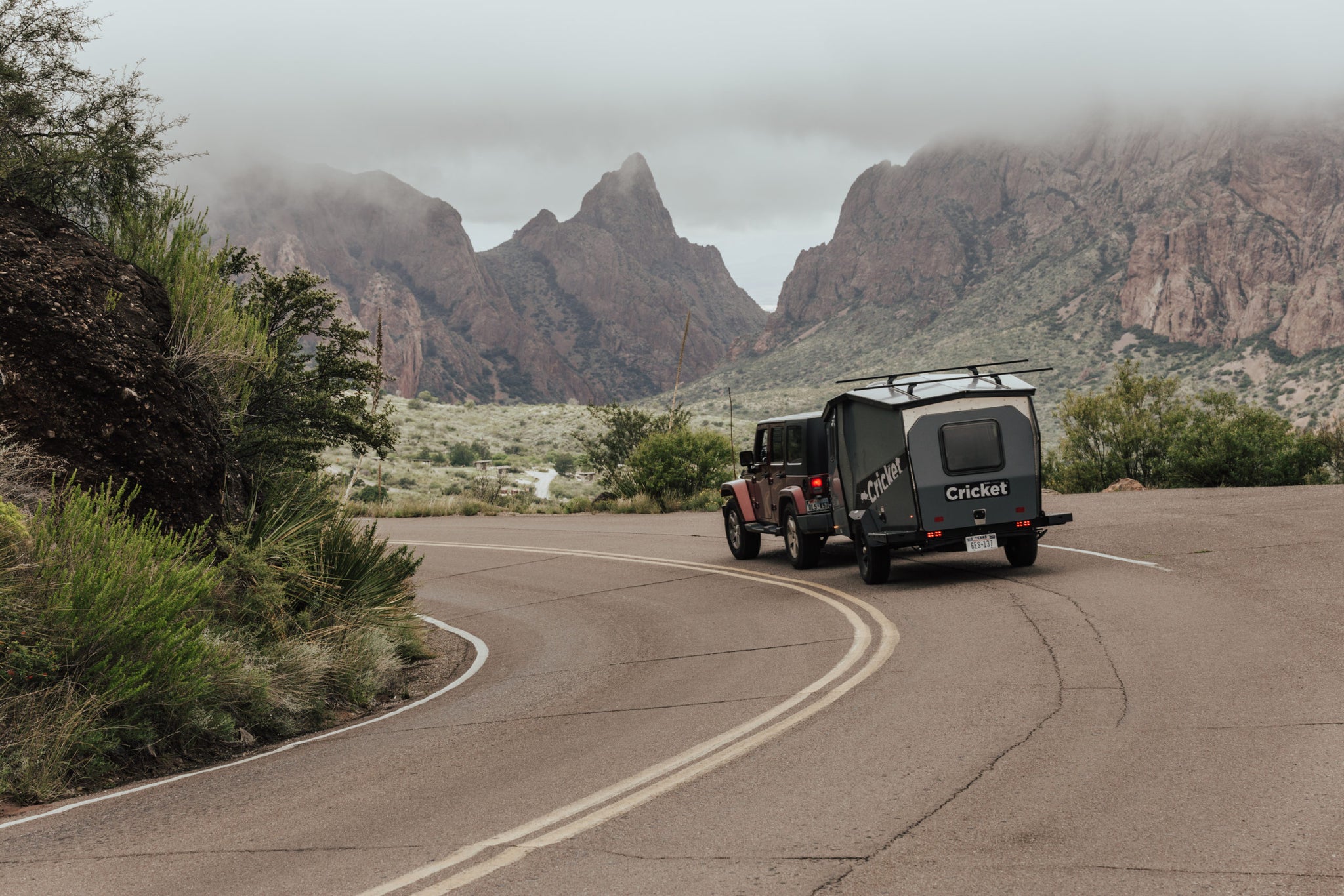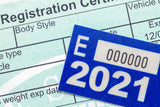So, you’ve finally done it! You’ve bought the TAXA habitat of your dreams. Already, you can envision yourself towing your trailer along mountain roads and parking up next to beautiful lakes and waterfalls. There’s just one teeny-tiny problem — you’ve never towed a day in your life. Now what?
The good news is it’s really not that hard to learn. Take it from me! I learned to tow my 22-foot RV in just three weeks before taking off on a full-time adventure. I’ve been on the road since September 2020 and have had an amazing experience.
Find what you’re looking for:
- Why understanding towing safety is important
- Before you attach your trailer
- How to hook up your trailer
- How to drive while towing
- Parking your trailer
- Other towing FAQs
Why understanding towing safety is important
Ready for your first towing adventure with that new camper or trailer? Exciting, right? But, pump the brakes a little — safety comes first, not just for you but for everyone on the road. Without the right knowledge, accidents, vehicle damage, and unnecessary stress can lurk around the corner.
Is it hard to tow a trailer for the first time?
Towing a trailer for the first time may seem daunting, but with the right knowledge and preparation, it doesn't have to be difficult. Like any new skill, practice and patience are key. Take the time to familiarize yourself with your vehicle and trailer, and practice towing in a controlled environment before hitting the open road.
Thankfully, this guide's got your back. It's your shortcut to essential towing know-how, ensuring a safe and enjoyable journey. Buckle up for a smooth towing debut!
Before you attach your trailer
Before you start getting your trailer hitched up to your vehicle, there are some checks and items you should consider first:
Make sure your vehicle can actually tow your trailer
Understanding your vehicle's towing capacity is the first step to safe towing. Check your vehicle's manual or consult the manufacturer's guidelines to find its maximum towing capacity. This figure will help you assess whether your camper or trailer falls within the acceptable weight range. Exceeding the towing capacity can strain your vehicle's engine, transmission, and brakes, leading to safety hazards and potential damage.
For more information, see our in-depth guide on understanding trailer weights, or check out our guide to common tow vehicles.
Check your tires
Before hitting the road, thoroughly inspect the tires on both your tow vehicle and trailer. Underinflated or worn-out tires can compromise stability and increase the risk of blowouts, especially when towing heavy loads.
During a long trip up to Wyoming from California, I almost had a double blow-out. I did check my tires, but when you’re still learning, you’re not always sure what to look for. Here’s my advice:
- Check the tread of your tires to ensure they haven’t worn down
- Check the sidewall of the tires for cracks
- Check the seams of the tires to see if you see any splitting or lifting
- Check the PSI of your tires to ensure they match the recommendations for your trailer or for that specific tire
- Make it a habit to regularly monitor tire pressure throughout your journey
- Remember to check the spare tire
Get tow mirrors
When it comes to towing, visibility is king, and regular mirrors might not cut it. Enter clip-on or extended mirrors — absolute must-haves that latch onto your existing side mirrors (although TAXA campers are skinny enough that these typically aren’t necessary). Adjust them just right, and voila! Those pesky blind spots are history, giving you the upper hand for lane changes, merges, and parking with confidence.
Get safety chains
These are crucial safety features, providing a backup connection between your tow vehicle and trailer in case the primary hitch fails. Cross the safety chains under the trailer tongue and attach them to the hitch on either side. Make sure they're snug but not dragging on the ground. These chains are your fail-safe, ensuring your tow vehicle and trailer stay connected, no matter what.
Follow the 60 / 40 rule
Have you ever heard of the tail wagging the dog? It happens when you fail to load a trailer properly. To prevent this from happening, use your axle as a marker. Then, enter the camper and make a note of where the axle runs underneath. When you load your personal items, try to keep 60% of the weight toward the front of the camper and 40% of the weight toward the back (this doesn’t have to be exact, just do a rough estimate).
Plan gas stops ahead of time
Before hitting the road, factor in the refueling game plan with your trailer in tow. Opt for larger gas stations, as they offer more elbow room for smoothly maneuvering your vehicle and trailer. Assess the accessibility of gas stations along your route, ensuring their entrances and exits can handle your entire setup.
How to hook up your trailer
While every trailer is different, the broad steps you’ll need to follow for hooking your camper up to your vehicle are:
- Position Your Vehicle: Back your vehicle up to the trailer, aligning the hitch ball with the trailer coupler. Take your time and make precise adjustments to ensure a proper connection.
- Lower the Trailer onto the Hitch: Use the trailer jack to gradually lower the trailer onto the hitch ball. Be attentive to prevent any sudden drops that may damage the hitch or trailer.
- Lock the Coupler: Once the trailer is securely on the hitch ball, lock the coupler in place. Double-check that the locking mechanism is engaged, providing an extra layer of security.
- Connect Safety Chains: Cross the safety chains under the trailer tongue and attach them to the hitch on either side. Ensure they are crisscrossed to form an "X" shape, providing stability in case of a hitch failure.
- Attach Trailer Wiring: Connect the trailer's wiring harness to your vehicle. Test all lights and signals to confirm they are functioning correctly. Proper lighting is essential for safe towing, making your intentions clear to other drivers.
How to drive while towing
Taking your trailer on that first trip is an exciting but nerve-wracking experience. I still remember my sweaty palms and the butterflies in my tummy the first time I merged into Atlanta’s 16-lane highway traffic with my 22-foot trailer. I had an incident-free towing experience, so let’s do our best to ensure you do too.
Calm yourself before towing your trailer
When you finally take your camper out for that first trip, you need to be calm. If you’re too tense at the wheel, you run the risk of over-correcting at the smallest provocation, which can be dangerous. Once you’ve been on the road for about 15 minutes or so, you’ll likely start to relax and feel more at ease.
Adjust your brakes
Your trailer or truck may or may not have adjustable brakes. For example, I can adjust my trailer brakes from inside the truck. If yours are adjustable, put your hazards on and drive a few feet down the street. Then, use the brakes normally. If your trailer stops too suddenly, turn the brake strength down. If you feel no assistance in braking from the trailer, up the number.
Practice towing your trailer
Once or twice per week, I would drive 1 hour and 15 minutes to the acreage I stored my trailer on. At first, I only towed it around the property. On the second solo trip, I took the trailer back to a Walmart parking lot that I used to practice parking to get used to a different environment.
Speed
Keep it steady and moderate. Going too fast can lead to trailer sway, where your trailer oscillates from side to side, playing havoc with your stability. Stick to the speed limits set by your vehicle's maker for towing. If sway does sneak in, gently ease off the gas and avoid heavy braking. You can also consider investing in a trailer sway control system, which enhances stability and control during your journey.
Turning
Turning with a trailer requires a different approach compared to solo driving. Given the extended length of your setup, opting for wider turns is key to avoid the trailer cutting corners or colliding with obstacles (and other vehicles). Consistently check your tow mirrors to track the trailer's position and ensure it sticks to the planned swing path. A bit of practice in an open area before venturing onto the road can go a long way in getting comfortable with the nuances of turning while towing.
Hills and inclines
Navigating inclines with a camper or trailer demands a careful approach. When heading uphill, keep a consistent speed and avoid abrupt accelerations. If your vehicle is struggling with the incline, think about downshifting to a lower gear for that extra torque. On the way down, opt for lower gears to manage your speed, minimizing reliance on brakes that might overheat and jeopardize safety.
Be aware of how things feel
While on the road with your trailer, keep an eye on how your vehicle and trailer behave and feel. If you sense odd vibrations or catch unfamiliar sounds, don't brush them off — tackle them right away. Any shifts in handling, responsiveness, or stability warrant attention. If things seem off, find a safe spot to pull over and give your setup a thorough once-over.
Follow road etiquette
Stick to the right lane on highways, giving faster-moving vehicles a clear path to pass safely. Signal your intentions well ahead of any maneuvers and exercise caution when changing lanes. Keep a safe following distance, allowing for ample reaction time, and steer clear of tailgating. A touch of consideration for fellow drivers ensures a smoother and safer experience for everyone sharing the road.
Towing in inclement weather
Navigating difficult weather while towing demands extra care. Rain or snow means slippery roads, so ease up on the accelerator, reduce your speed, and extend your following distance to accommodate longer braking distances. Keep a steady grip on the steering wheel, especially in gusty winds that can sway or push your trailer. If conditions turn too perilous, consider delaying your journey. Safety should always be your compass, guiding adjustments to your driving to match the weather conditions.
Parking your trailer
Parking a trailer can be a challenging task for first-time towers, but with practice and patience, it becomes more manageable. Take the time to develop your skills in various scenarios, and soon you'll be confidently navigating parking spaces and campsites on your outdoor adventures.
- Understand Your Trailer's Dimensions: Familiarize yourself with the dimensions of your trailer, especially its length and width. Knowing these dimensions will help you gauge the space needed for parking.
- Choose an Open Area for Practice: Before attempting to park your trailer in a tight space, find an open area like an empty parking lot. This allows you to practice maneuvering without the pressure of obstacles.
- Practice Straight-Line Backing: Start by practicing straight-line backing. Align your vehicle and trailer in a straight line, then slowly reverse while keeping an eye on both side mirrors. This fundamental skill will serve as the foundation for more complex parking maneuvers.
- Master Angled Parking: As you gain confidence with straight-line backing, progress to angled parking. Choose an open space with lines or markers and practice parking your trailer at various angles. Use your mirrors to guide you and pay attention to the relationship between your vehicle and the trailer.
- Use a Spotter When Available: If possible, have a spotter assist you when parking to provide guidance and help you avoid obstacles. Communication is key — establish clear signals beforehand, such as hand gestures or two-way radios.
- Use Reference Points: Develop reference points to gauge your trailer's position. For example, identify a spot on your vehicle or trailer that aligns with a specific point on the ground. This helps you maintain control and accuracy during parking.
Other tried and true advice
There was one YouTube video that changed my life:
It is half an hour long, but it’s worth watching. The video taught me the theory behind backing in, which made the practical aspect of it much easier. I watched it every day for a week before I first attempted to back up my trailer.
Some of these tips I learned from watching the video. Others, I’ve learned during my travels:
- If possible, install a backup camera on your camper, but only use it to ensure you aren’t about to hit something.
- When backing in, always start with the site on the driver’s side. This is much easier because you have better visibility.
- If you’re backing up solo, do it at an angle. It’s easier to monitor the turning radius than it is to guess what’s directly behind your trailer.
- Even if you have the world’s best spotter, always get out and look at the site for yourself.
- If you have a spotter, agree from the start what they mean by left or right. This might sound silly right now, but it will make sense once you try it.
- Use the bottom of your steering wheel as a guide. If you turn from the bottom to the left or right, the back end of your trailer will do the same.
- Your trailer will not turn immediately, so budget for it to go the wrong way first when getting into tight spaces.
Congratulations! You now have all the basic information you need for towing your trailer. Need some one-on-one advice? Talk to a TAXA Adventure Specialist today!
Other towing FAQs
Are there age restrictions for towing?
Age restrictions for towing vary by location. In many places, you need to be at least 18 years old to tow a trailer. Check local regulations to ensure compliance.
Can you tow in the left lane?
In most cases, it's recommended to stay in the right lane while towing. Use the left lane for passing only, as driving in the left lane can impede traffic.
What causes fishtailing?
Fishtailing (or trailer sway) occurs when a trailer swings from side to side. It can result from uneven weight distribution, improper loading, or high speeds. Properly distribute weight, load your trailer evenly, and drive at a safe and moderate speed to prevent fishtailing.
Can you tow with a full water tank?
Towing with a full water tank adds extra weight and can impact your vehicle's towing capacity. Consider emptying the tank before towing and fill it at your destination if needed.


